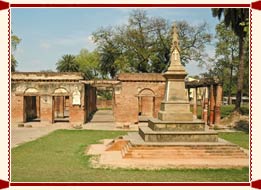 The
Residency is actually a group of buildings that were built in 1800 A.D
by the then Nawab of Oudh, Nawab Saadat Ali Khan. It was constructed in
order to serve as the residence for the British Resident General who was
a representative in the court of Nawab. The palace was rather a sleepy
residence for decades but then came an incident, which put it on the
world map.
The
Residency is actually a group of buildings that were built in 1800 A.D
by the then Nawab of Oudh, Nawab Saadat Ali Khan. It was constructed in
order to serve as the residence for the British Resident General who was
a representative in the court of Nawab. The palace was rather a sleepy
residence for decades but then came an incident, which put it on the
world map. The year 1857 will always be mentioned in the chronicles of history because of its dramatic sequence of events. The year saw the Sepoy Mutiny, which is also sometimes referred as 'The First War of Indian Independence'. Lucknow also became one of the seats of that uprising. The Residency became one of the most talked about battlement during the siege of Lucknow. The mutineers laid the siege on The Residency in early June that year. Nearly all the Europeans who resided in the city of Awadh took shelter in Residency. It is said that as many as 3500 people sought shelter during the siege. The siege continued for more than 140 days.
The saga of the siege of 'The Residency' will go down in the history of India as a brave effort done by handful of Men, women and children to thaw the efforts of mutineers. The residence of the palace held together during the continuous shelling that lasted for a month. The canon balls withered the walls of residency but the palace held miraculously. Sir Henry Lawrence who bore the responsibility 3500 human lives undertook the defense and counter initiative. The brave-heart fall on the last days of siege. The reinforcement force rescued the palace after 5 months.
The redbrick ruins are peaceful now a days, surrounded by lawns and flowerbeds, but thousands died during the months-long siege. The Residency has been maintained as it was at the time of the final relief, and the shattered walls are still scarred by cannon shot. Even since Independence, little has changed. A brooding silence engulfs the ruins and one almost expects the ghosts of the dead to suddenly materialize and flit across the rooms. The cemetery at the nearby ruined church has the graves of 2000 men, women and children, including that of Sir Henry Lawrence who died defending the empire. There is a weathered epitaph near the grave of Sir Lawrence that reads " Here lays the son of Empire who tried to do his duty".










